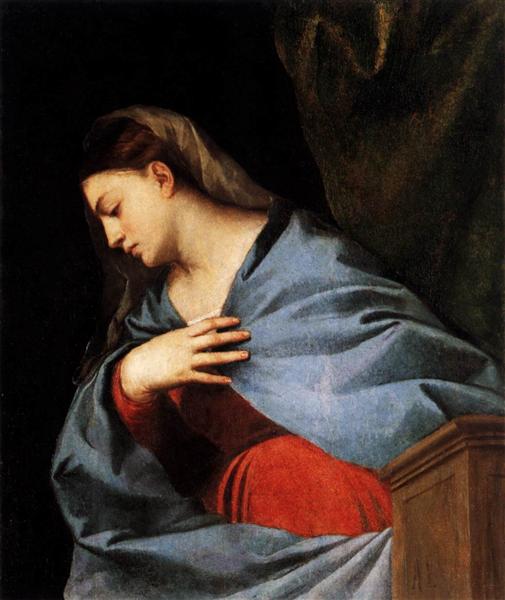Beskrivelse
The "Polyptych of the Virgin Announcing the Resurrection," created by Titian in 1522, is a work that contains both spiritual and compositional depth, reflecting the Renaissance painter's mastery in the representation of religious themes. Titian, a leading exponent of the Venetian School, has the ability to fuse narrative with emotion, which is masterfully manifested in this complex and richly symbolic work.
The composition of the polyptych is articulated around a structure that evokes both the verticality and the sacredness of the subject. In the centre, the figure of the Virgin Annunciate stands gracefully, her posture and expression capturing a moment of divine revelation. This depiction is characteristic of Titian's emphasis on the human figure, where naturalism and idealisation are intertwined. The delicate tilt of the Virgin's head and the softness of her face convey a sense of calm and acceptance, symbolising the crucial moment of the Annunciation.
The colours Titian uses are vibrant and nuanced, highlighting a palette that oscillates between gold, blue and flesh tones. The light, a central element in the master's work, seems to come from an inner source, illuminating the Virgin in such a way that her figure stands out against the darker background. This technique not only creates a deep visual contrast, but also suggests a spiritual illumination, lending the scene an aura of the sacred.
In terms of characters, although the work focuses primarily on the Virgin, the inclusion of angels in some of the surrounding panels underlines the celestial connection of the scene, reinforcing the idea of its importance in Christian narrative. Furthermore, the polyptych, in its entirety, becomes a visual narrative that invites the viewer to consider the interrelationship of the human and the divine, a recurring theme in the Renaissance.
The use of the polyptych as an artistic form also deserves attention. With this work, Titian aligns himself with medieval and Renaissance practices that sought to tell complex stories through multiple panels. The arrangement of the elements takes the observer into an almost ritualistic experience, where each section invites contemplation and reflection on sacred history.
Stylistically, the "Polyptych of the Virgin Announcing the Resurrection" is set in the context of a renaissance in Italian art that focused both on the faithful representation of the human figure and on the exploration of light and color. Like other masters of his time, such as Giovanni Bellini and Andrea Mantegna, Titian employs a technique of loose brushstrokes that lend a vitality and dynamism to his works. However, it is his unique ability to convey emotion through color and form that sets him apart.
Through this polyptych, Titian not only establishes a visual narrative linked to the sacred, but also explores the complexity of human experience in the face of the transcendent. In this sense, the work is not only an artistic object, but a portal to a broader reflection on the connection between the earthly and the divine, thus becoming a testimony to the mastery and evocative power of Renaissance art.
KUADROS ©, a famous painting on your wall.
Hand-made oil painting reproductions, with the quality of professional artists and the distinctive seal of KUADROS ©.
Painting reproduction service with satisfaction guarantee. If you are not completely satisfied with the replica of your painting, we will refund 100% of your money.

